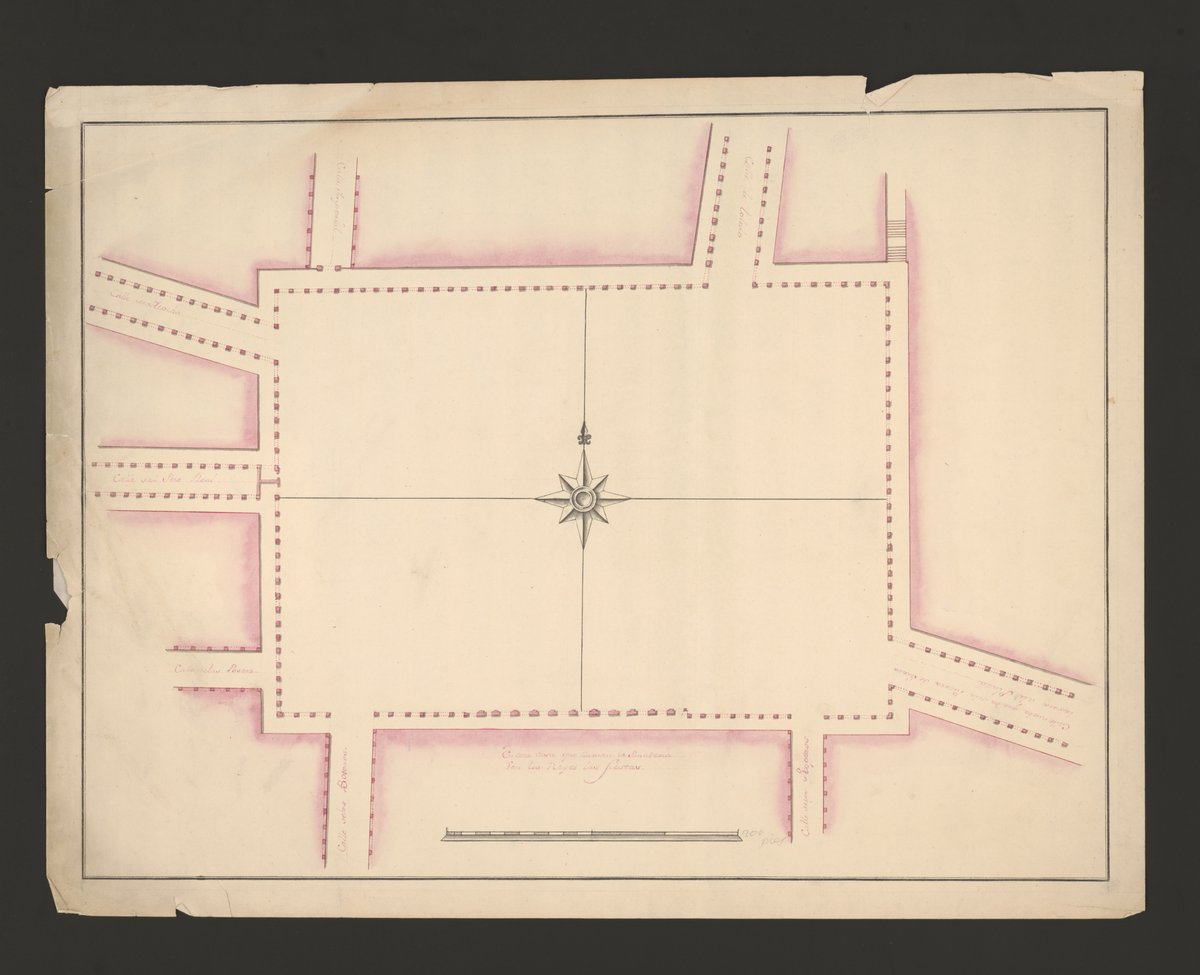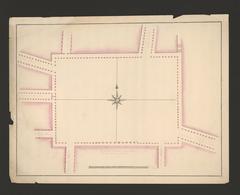
Comprehensive Guide to Visiting Casa de la Panadería, Madrid, Spain
Date: 15/07/2024
Introduction
Nestled in the bustling heart of Madrid’s Plaza Mayor, the Casa de la Panadería stands as a testament to Spain’s rich cultural and architectural heritage. Originally constructed in 1590 by architect Diego Sillero, this striking edifice was initially designed to serve as the city’s main bakery, catering to the royal family and Madrid’s elite. The building’s name, which translates to ‘Bakery House,’ underscores its humble beginnings (Madrid.es). Over the centuries, the Casa de la Panadería has evolved, enduring fires and renovations, to become a significant historical and cultural landmark in Madrid. Its symmetrical design, crowned by angular towers and adorned with frescoes, showcases the architectural brilliance of the Spanish Golden Age (Lonely Planet). Today, it houses the city’s main tourist office and serves as a hub for cultural activities, making it a must-visit for anyone exploring Madrid (InSpain). This comprehensive guide aims to provide visitors with essential information on the history, architectural significance, visiting hours, ticket details, and tips for making the most of their visit to this iconic site.
Table of Contents
- Introduction
- History and Significance
- Cultural and Social Impact
- Architectural Features
- Preservation and Restoration
- Visitor Information
- FAQ
- Conclusion
History and Significance
Origins and Early History
The Casa de la Panadería, located on the north side of the Plaza Mayor in Madrid, has a rich history dating back to the 16th century. Initially constructed in 1590 by architect Diego Sillero, the building was designed to serve as the city’s main bakery, providing bread to the royal family and the city’s elite. The building’s name, “Casa de la Panadería,” translates to “Bakery House,” reflecting its original purpose (Madrid.es).
Architectural Evolution
The Casa de la Panadería has undergone several reconstructions and renovations over the centuries. The initial structure was almost completely destroyed in a fire on August 20, 1672. The reconstruction, which lasted 17 months, was overseen by architect Tomás Román. The building was adorned with frescoes by painters Claudio Coello and José Jiménez Donoso (Wikipedia).
The building’s design features a symmetrical composition with four stories, a porticoed ground floor, and an attic on the top floor. The sides are crowned by angular towers, adding to its architectural grandeur. The frescoes on the facade, which were restored in 1992 by artist Carlos Franco, depict images from the signs of the zodiac and various gods, providing a stunning backdrop for the Plaza Mayor (Lonely Planet).
Historical Significance
The Casa de la Panadería has played a crucial role in Madrid’s history. During the reign of the Habsburg dynasty, it served as a meeting place for the Spanish Inquisition’s tribunals, where accused heretics were interrogated and tried. The building’s walls hold silent witness to the harrowing tales of those who faced persecution during this dark period of Spanish history (InSpain).
In the 18th century, the building housed the Royal Academy of Fine Arts of San Fernando from 1745 to 1774, and later the Royal Academy of History from 1774 to 1871. In the 20th century, it served as the Municipal Archive and Library of Madrid. Today, the Casa de la Panadería is home to the city’s main tourist office, providing information and services to visitors (Madrid.es).
Cultural and Social Impact
The Casa de la Panadería has been a focal point for various cultural and social events throughout its history. The building’s central location in the Plaza Mayor made it an ideal venue for public events, including markets, festivals, and celebrations. The Plaza Mayor itself has been the site of numerous historical events, including royal coronations, bullfights, and public executions (Ferrovial Blog).
One of the most notable events associated with the Casa de la Panadería is the annual Christmas market, which takes place in the Plaza Mayor. This market, known as the “Mercado de Navidad,” features stalls selling Christmas decorations, gifts, and traditional Spanish treats. The festive atmosphere attracts both locals and tourists, making it a beloved tradition in Madrid (Madrid.es).
Architectural Features
The Casa de la Panadería’s architectural features are a testament to its historical and cultural significance. The building’s facade is adorned with intricate frescoes that depict various mythological and historical scenes. These frescoes, restored in 1992, add to the building’s visual appeal and historical value (Lonely Planet).
The building’s interior is equally impressive, with a grand staircase leading to the upper floors. The Hall of Columns, located on the first floor, is a notable feature of the building. This hall, which once served as a meeting place for the Spanish Inquisition, is now used for various cultural events and exhibitions (InSpain).
Preservation and Restoration
Over the years, the Casa de la Panadería has undergone several restoration efforts to preserve its architectural integrity and historical significance. These efforts have focused on maintaining the original design and materials while incorporating modern techniques to ensure the building’s stability and longevity. The most recent restoration, completed in 1992, included the restoration of the frescoes on the facade and the repair of the building’s roof and spires (Ferrovial Blog).
Visitor Information
Visiting Hours and Tickets
The Casa de la Panadería is open to visitors throughout the week. The visiting hours are typically from 10:00 AM to 8:00 PM, but it’s advisable to check the official website for any changes or special closures. Admission is free for all visitors, making it an accessible destination for both locals and tourists (Madrid.es).
Guided Tours
Guided tours of the Casa de la Panadería are available, providing visitors with an in-depth exploration of the building’s history, architecture, and cultural significance. These tours offer insights into the stories behind the Casa de la Panadería and its place in Madrid’s rich tapestry. One of the highlights of the tour is the rooftop terrace, which offers breathtaking views of the city of Madrid (InSpain).
Travel Tips
- Accessibility: The Casa de la Panadería is easily accessible by public transportation, with several metro stations nearby, including Sol and Ópera. Visitors can also explore the area on foot, as the Casa de la Panadería is within walking distance of many other notable attractions in Madrid.
- Nearby Attractions: In addition to the Casa de la Panadería, visitors can explore other nearby attractions such as the Royal Palace, Almudena Cathedral, and the Mercado de San Miguel.
- Photography: The building’s facade and interior offer numerous photographic opportunities. The rooftop terrace, in particular, provides stunning panoramic views of Madrid.
FAQ
What are the visiting hours for Casa de la Panadería?
The Casa de la Panadería is typically open from 10:00 AM to 8:00 PM. However, it’s best to check the official website for any changes or special closures.
How much are tickets to Casa de la Panadería?
Admission to the Casa de la Panadería is free for all visitors.
Conclusion
The Casa de la Panadería stands as a testament to Madrid’s rich history and cultural heritage. Its architectural beauty, historical significance, and central location make it a must-visit destination for anyone exploring the city. Whether you’re interested in history, architecture, or simply looking to experience the vibrant atmosphere of the Plaza Mayor, the Casa de la Panadería offers a unique and memorable experience.
Call to Action
For more updates on Madrid’s historical sites and events, follow us on social media and download our mobile app Audiala. Don’t forget to check out our other related posts for more travel tips and guides.
References
- Madrid.es. (n.d.). Casa de la Panadería. Retrieved from Madrid.es
- Wikipedia. (n.d.). Casa de la Panadería. Retrieved from Wikipedia
- Lonely Planet. (n.d.). Real Casa de la Panadería. Retrieved from Lonely Planet
- InSpain. (n.d.). Casa de la Panadería. Retrieved from InSpain
- Ferrovial Blog. (2015). A Quick Stroll Through the History of the Casa de la Panadería in the Plaza Mayor. Retrieved from Ferrovial Blog


































































































